Mind games, chess moves at play as Warriors, Thunder prep for Game 3

Get all of Ben Golliver's columns as soon as they’re published. Download the new Sports Illustrated app (iOS or Android) and personalize your experience by following your favorite teams and SI writers.
OKLAHOMA CITY — There were no obvious signs of demoralization at Thunder practice Friday, where the basketballs bounced in business-like rhythm and coach Billy Donovan struck an optimistic and measured tone two days after a Game 2 blowout loss to the Warriors.
The 27-point defeat, brought on by Stephen Curry’s latest onslaught, denied Oklahoma City a commanding 2-0 lead, but it didn’t rob the Thunder of their confidence. Indeed, spirits were high enough to throw a few subtle jabs at Golden State’s stars.
When the topic of Curry’s much-discussed dive into the courtside seats was raised, Kevin Durant smirked as he offered his assessment.
“He didn’t have to jump over,” Durant said. “I thought he could have leaned into the fans in the first row. But it looks good when you jump over. I understand that.”
Later, Thunder center Steven Adams, who was on the receiving end of a below-the-belt shot and plenty of trash-talking from Warriors forward Draymond Green during Game 2, sent a little back the other direction.
“He’s peaked with annoyingness,” Adams said.
Informed of Adams’s assertion at Golden State’s practice in Oakland, Green replied by making it clear he had bigger fish to fry.
“Tell [Adams] thanks for letting me know. I appreciate it,” Green said. “I don't go into the game saying I need to get in Steven Adams's head. I go in the game saying I need to do whatever I need to do to help this team win, and if that bothers someone else, then they need to figure out what they need to do.
“My goal is definitely not to get in Steven Adams's head. I mean, if anybody, it's trying to get into [Durant’s] and Westbrook's head.”
• Open Floor: Warriors-Thunder, NBA draft lottery, Knicks news and more
The two-way dismissiveness—Durant towards Curry and then Green towards Adams—neatly mirrored the back-and-forth nature of this series to date. Oklahoma City’s surprising Game 1 win preceded a vastly different Game 2, one in which Golden State ratcheted up the defensive intensity. Central to that effort was Green, who roamed at will to provide help defense on Durant and Westbrook.
In some cases, Green’s unorthodox positioning was borderline eye-popping. Here, he stands at the elbow, a good 10 feet away from any Thunder player in any direction.
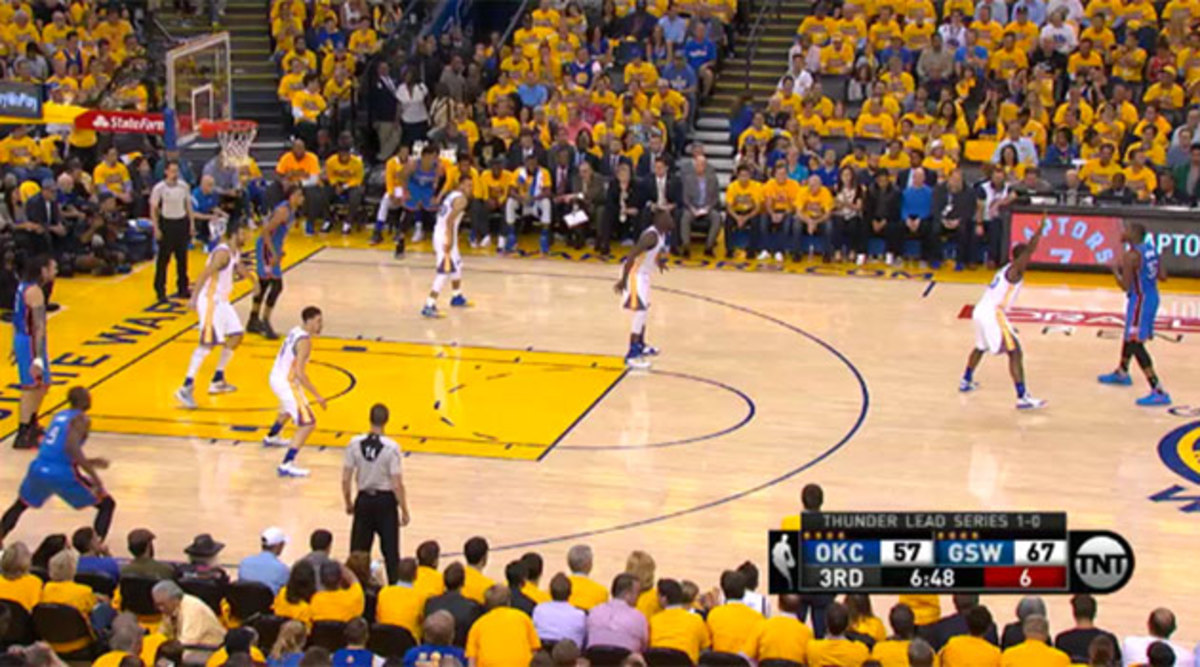
Green is able to create this confusion because his “man” is Andre Roberson, a poor shooter and a limited offensive player who doesn’t require a tight cover.
Here’s what’s so striking about the above image: Green isn’t guarding anybody, but no one is open. Golden State has all five Thunder players covered even with Green occupying empty real estate. Andrew Bogut is essentially guarding two players, Adams and Roberson, but Durant has no easy passing lanes to either player.
What’s more, Green’s decision to lay off as a secondary line of defense rather than pressure Durant all out on the perimeter takes away Durant’s ability to turn the corner on a double team and find a soft spot for a pull-up jumper. It also puts him in position to provide immediate help on Westbrook should he break towards the ball from the right corner.
• MORE NBA: The Giant Killer: Draymond Green dares you to define him
On this particular play, Durant picks up his dribble early in a spontaneous basketball version of, “What the hell is going on?” Predictably, a turnover—one of eight on the night for Durant—ensues.
The Warriors ignored Roberson early and often. This wasn’t a case of “cheating” or “sagging” but rather downright neglect. Midway through the first quarter, Durant drove to the hoop and found all five Warriors collapsing into the paint to surround him.
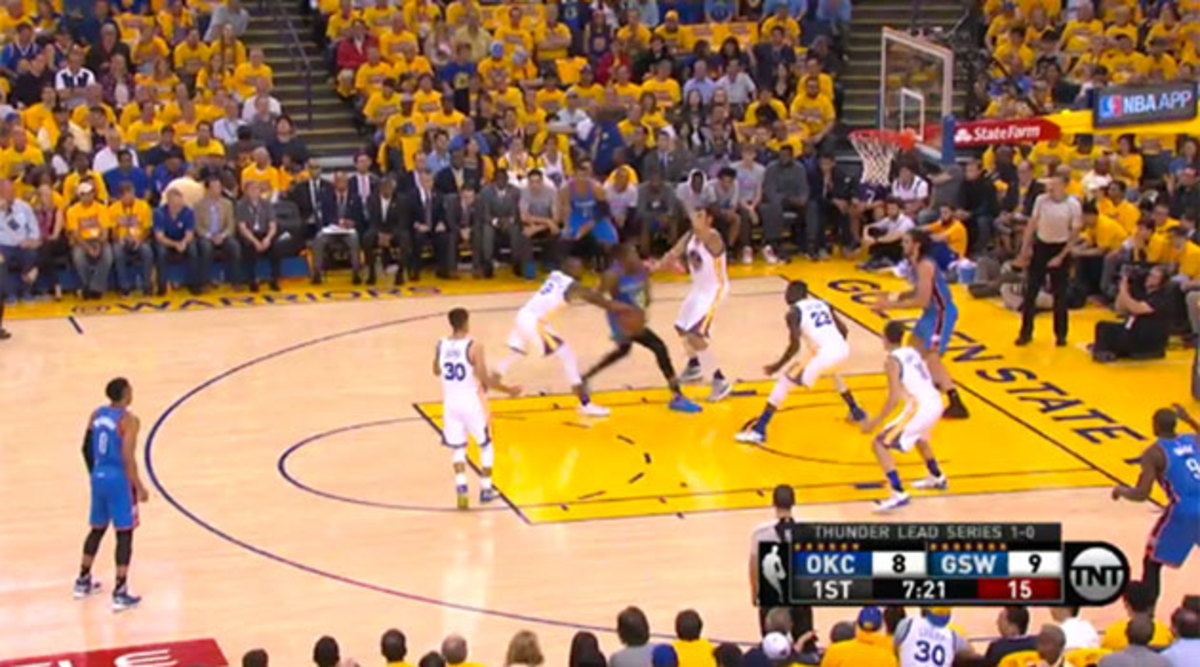
Westbrook is open at the top and Ibaka is open in the right corner, but Roberson is really, really open in the left corner. Bogut certainly isn’t going to be able to close out in time and Green is far more concerned with defending the rim and Adams. Durant never considered the short kick-out pass to Roberson and the ball was stripped before he could get off a shot.
Shortly thereafter, Green provides help on a Westbrook drive in such a way that leaves Roberson open above the break by 15 feet. This is a simple math play: Roberson shot 31% on threes this season and he’s shooting 27% during the playoffs.
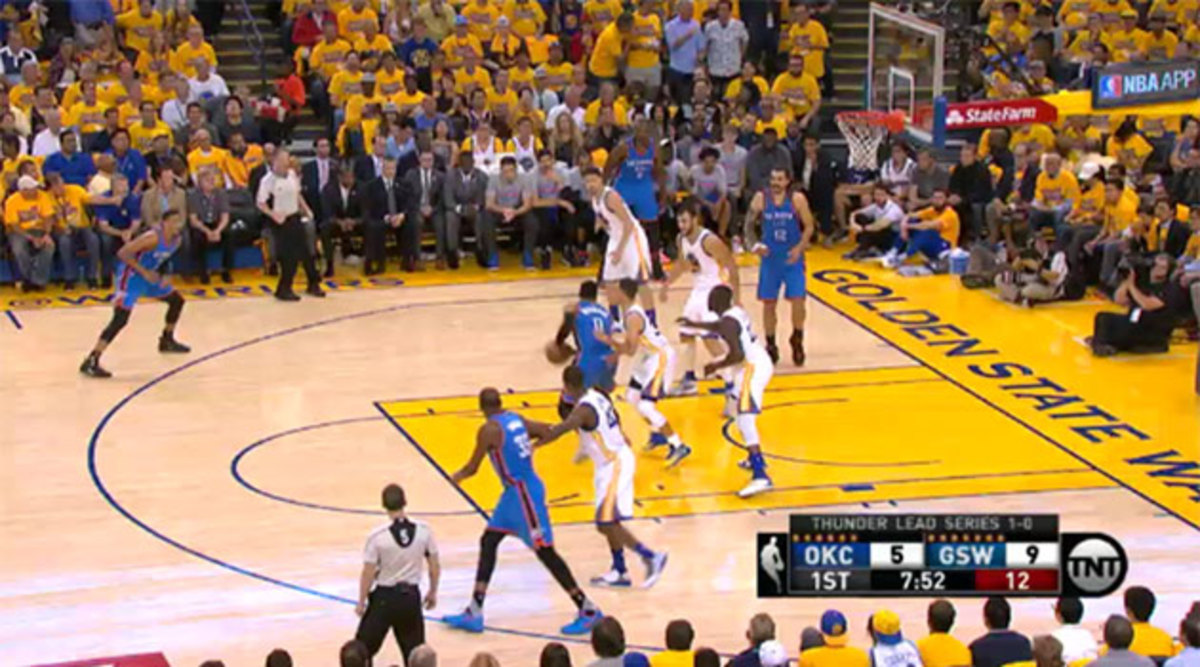
He happened to make this one, but the Warriors are making a bet (a very safe one) that he won’t take and make enough to truly hurt them. Any possession that ends with a Roberson jumper, no matter how wide open, is almost guaranteed to be better than one in which Durant or Westbrook is allowed to create a shot or a scoring opportunity. Plus, Roberson’s career-highs for made threes (3) and threes attempts (5) are exceedingly modest by the Warriors’ potent standards.
Golden State has adopted this approach before—against Memphis’s Tony Allen last year, and against Portland’s Moe Harkless and Al-Farouq Aminu in the second round—but the stakes are higher and the visual impact is more stunning here. The 2015 Grizzlies were always battling spacing issues due to their two-big frontline and lack of wing shooters. The Blazers didn’t have anything going on inside offensively thanks to a weak center rotation and guards who lacked the length and explosiveness to finish against the Warriors’ bigs.
• MORE NBA: Kyrie Irving has Cavaliers rolling toward the NBA Finals
The Thunder, by contrast, are used to getting to the basket and to the free throw line thanks to their stars. They’re used to making due in tight quarters. And they’re used to beating standard double-teams and helps by finding the open man. What they’re not used to is a player with Green’s quickness, strength and basketball intelligence occupying valuable real estate, clogging passing lanes and blitzing into a double team at a moment’s notice, all while being unencumbered by a defensive assignment of his own. The Thunder are also not used to a team that can shift from this look into a more traditional approach on any given possession.
While Donovan credited Green’s defensive skills Friday, saying he “reads and sniffs things out very well,” he pushed back on the idea that Green’s neglect of Roberson had thrown a monkey wrench into the Thunder’s offense.
“In that first half, we're up two, and it really had no bearing on us,” he said. “We moved the ball pretty well. We shot a higher percentage in Game 2 than we did Game 1. I think that for us it was just a matter of getting good shots, creating good shots, making the extra pass and finding the open man. I think there were some sometimes that we did a good job of that, and there were some times we didn't do a good job of that.”
Some of that argument can surely be attributed to Donovan sticking up for a limited role player that he’s counting on for meaningful minutes in this series. After all, if there was a clearly better option than Roberson, Donovan would have already gone done that route. Roberson’s length, discipline and physicality on defense makes him a critical player for Oklahoma City, as Golden State’s wing rotation is deep, explosive and quite long itself.
Dumping Roberson entirely wouldn’t seem to be a viable option, and limiting his minutes only means asking more from the mercurial Dion Waiters, who went 3-for-11 during a rough Game 2 performance, and/or the uninspiring Randy Foye. While there may come a time in this series when Waiters enters the starting lineup in place of Roberson, it doesn’t seem like that time has quite yet arrived.
• MORE NBA: Mock Draft 4.0: Projecting first round with order now set
Another chunk of Donovan’s confidence can be attributed to a justified faith in Durant and Westbrook as both scorers and playmakers. Durant is capable of shooting over the top of four hands just as easily as he does over two hands, and he poured in the points early in Game 2 (when he wasn’t turning the ball over). In the second half, Westbrook was able to find the right crosscourt pass to a cutting Roberson down the baseline for a layup, flashing one solution for how to beat the extra defensive attention while also working around Roberson’s weak shooting.
Reading between the lines, the Thunder sound like they want to encourage Roberson to make more active use of the space he’s granted. Rather than sit back and line up a jumper he might very well miss badly, he might instead cut hard into the empty area in front of him, where he could receive a pass and then immediately become a threat to finish or make another pass that can beat the defensive rotation.
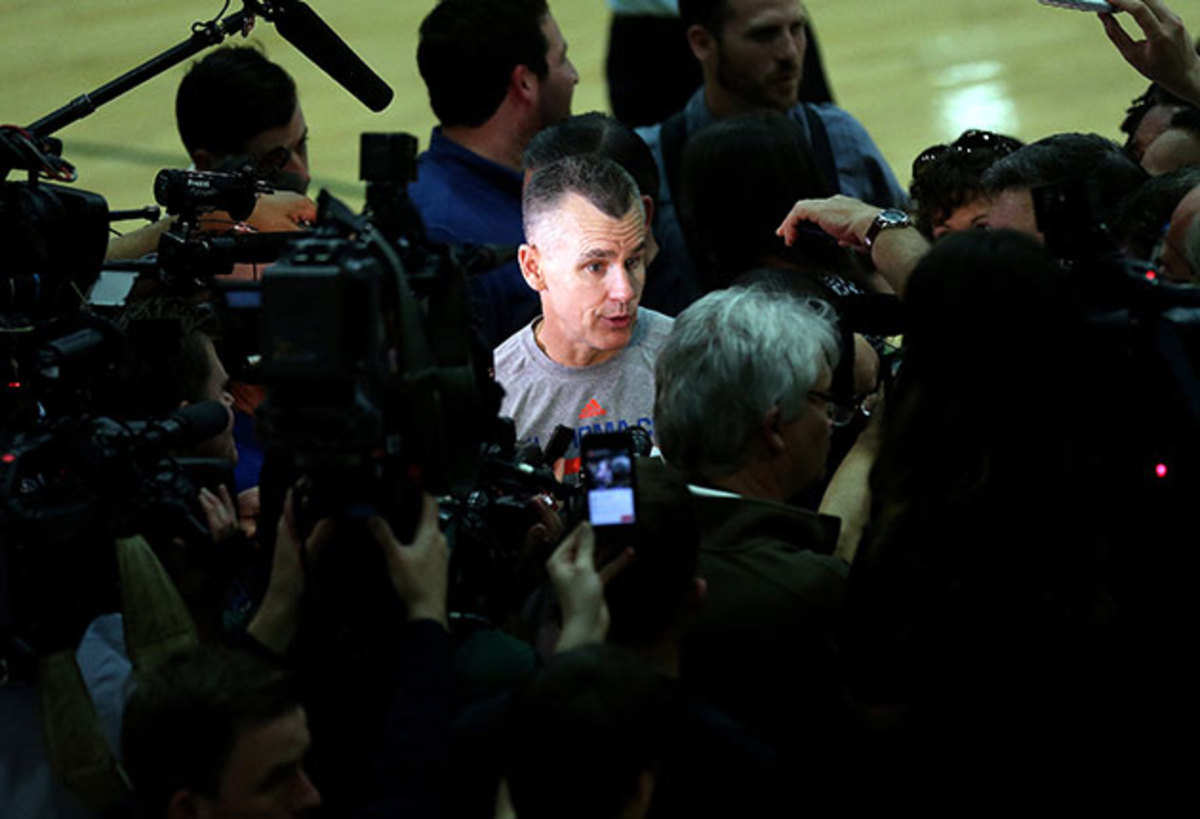
“It doesn't always mean that Andre's going to be open for a shot,” Donovan said. “But he may be open to create an opportunity for somebody else. … I think it all depends with Andre with the shot clock. If it's very, very early on the clock, I'm not so sure a three going up is the best thing. But certainly late clock, corner threes, he shot the ball very well from there. I think our feeling has always been to attack the paint and put pressure at the basket.”
This sounds good in theory, but faces some real obstacles in practice. Golden State’s big men, especially when playing with energy, make sound rotations and contest shots well in the basket area without fouling. Expecting Roberson to regularly finish shots in traffic or over the top of Golden State’s bigs is asking a lot. At the same time, Roberson isn’t accustomed to making loads of quick decisions. He averaged less than an assist per game this season because he’s the definition of a fifth option. There’s no guarantee that the opportunities he creates by passing in traffic while attacking will necessarily be better than the open corner three he’s opting not to take.
The same thing goes for Waiters and Foye, should the Warriors choose to ignore them in favor of loading up on the Thunder’s stars. Here’s another one of Durant’s turnovers, which resulted when he was more or less triple-teamed as the Warriors loaded up on him in the paint.
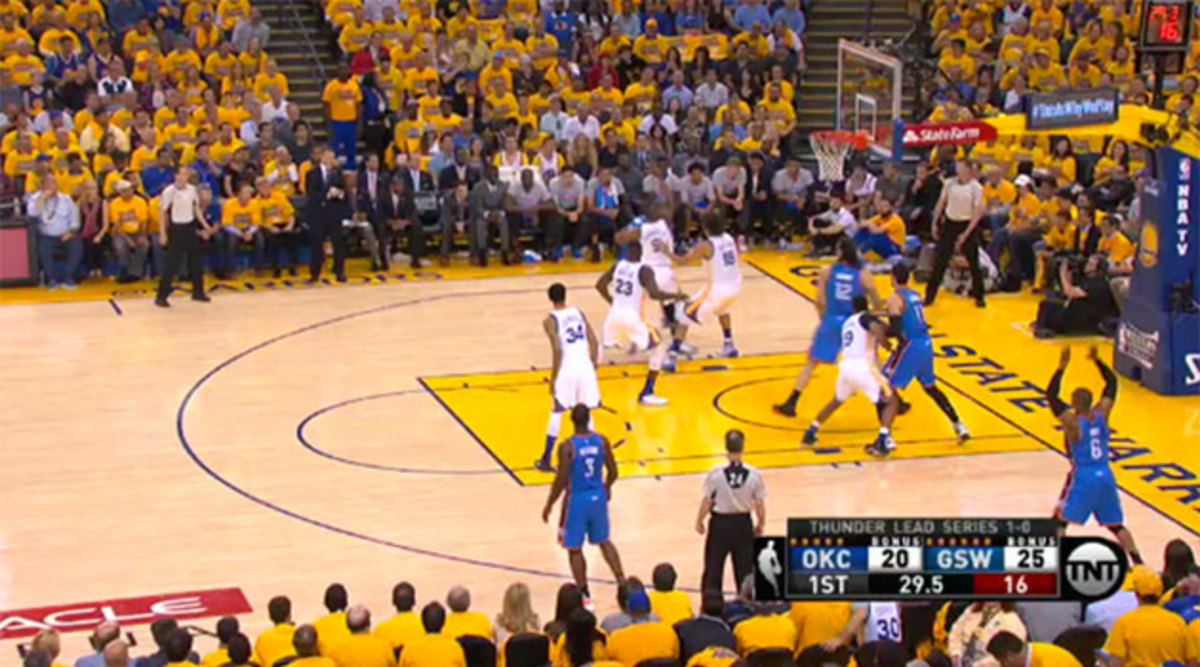
Still, the Thunder’s best bet seems to be countering the Warriors’ defensive activity with activity of their own. Fight fire with fire. Oklahoma City’s best shot at beating the roaming defense would seem to be quickly reversing the ball, penetrating from the weakside, and hoping to find seams to the basket, fouls via late rotations, or open looks for its better shooters in the ensuing scramble.
If that works, Durant and Westbrook should be able to reclaim enough oxygen to be more efficient than they’ve been in the first two games. If not, the Thunder will need to hope for a Herculean defensive effort of their own across the board. Otherwise, keeping pace with Curry and the Warriors will prove exceedingly difficult, if not impossible.
